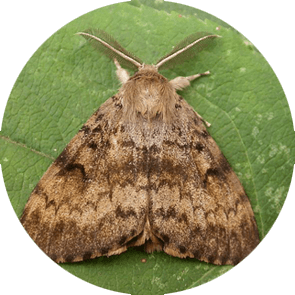


| Latin Name | Lymantria dispar |
| Common Name | Gypsy moth;Spongy moth; |
| Biology | Adult moths exhibit sexual dimorphism: males are strong fliers active during daytime, while females move sluggishly and mostly lay eggs at night, depositing egg masses on tree trunks, branches, or leaves. Larvae are highly polyphagous, feeding on foliage of various trees; during outbreaks they can defoliate entire forests, impairing tree growth or causing mortality. This species produces one generation annually, overwintering as egg masses on trees. |
| Damage | This pest primarily damages multiple forest and fruit trees including poplar, willow, elm, and birch. |
| Distribution Regions | North America and Eurasia |
| Monitoring | Pheromone lures mimic natural sex pheromones to attract male insects into specialized traps for population monitoring and suppression. As a core IPM component, monitoring enables early risk detection and targeted control. Mass trapping reduces mating opportunities to curb offspring populations. Protocols: ●Use only with matched traps. ●15-45 traps/hectare,replace/replenish every 4-6 weeks. ●Wear gloves or wash hands with detergent when switching lure types. ●Refer to trap-specific hanging instructions. |
| Recommended Traps | Delta Trap, Wing Trap |

分享您的联系信息,即可获得精准匹配的信息素解决方案。如果我们现有的产品组合缺乏最佳匹配,我们的合成化学团队将启动定制开发——从分子结构设计到规模化生产。